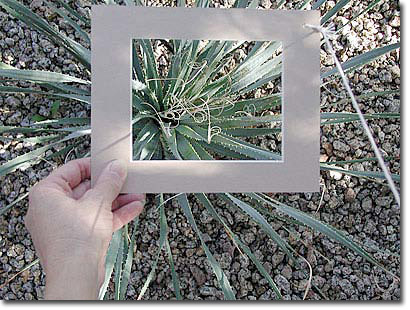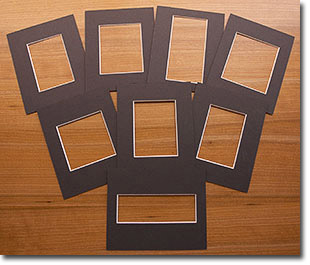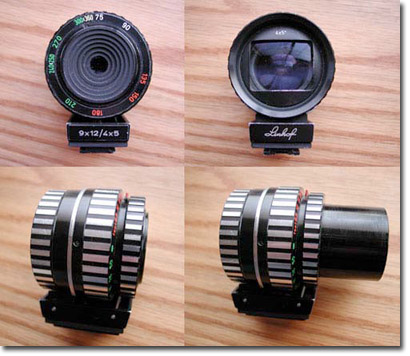Using a Viewfinder |
1 - What is a viewfinder?
A viewfinder is a viewing device that you use to visualize the scenes you plan to photograph. The simplest viewfinder is a cardboard cutout. This cutout is sized to the format of your camera sensor, or film. If you photograph with different formats you can use a different viewfinder for each format, or use a single viewfinder and visualize the croped image in your mind's eye.

2 - Viewfinders and Photography
When you are photographing, a viewfinder is a necessary tool. Why? Because a viewfinder helps you focus on one area in the landscape. Instead of looking at the entire landscape in front of you, you begin to "see" the landscape as individual parts. By moving the viewfinder closer or further from your eyes, from side to side, or up and down you change the part of the landscape you want to focus on.
By using the viewfinder and closing one eye, we begin to see like the camera sees. This helps us decide which elements to add to our image and which elements to subtract from our image. The result is a stronger photograph, one that is better seen than if we used the camera alone.
3 - Viewfinders and Painting
I use a viewfinder when I draw and paint because it also helps me focus on the edges of my painting. I can see where the painting begins and ends before I start. This helps me "pre-visualize" what the composition of the painting will be before I start drawing the composition on paper or canvas. I then adjust my viewfinder either closer or further away from the subject, side to side or up and down until I see a composition that I like. I am then ready to begin. The outcome of the painting or drawing is based on the decisions that I make along the way.
4 – Lenses change what we look at
There is a big difference between what you see looking through a cardboard viewfinder and through the camera viewfinder. This is because lenses modify what we look at.

5 - Turning 3-D into 2-D
When you use the viewfinder you have to close one eye. When doing that you go from binocular vision to monocular vision. You now see the world like a camera because cameras have only 1 eye: the lens. Looking at the world with only one eye transforms the three-dimensional world we live in into the two dimensional world that the camera captures. This is a good thing because what looks good in 3-D does not necessarily look good in 2-D. Knowing how the world will look like as a 2 dimensional image before taking the photograph will save you time and let you find good photographs faster.
6 – Squinting increases contrast
Squinting, closing your eyes slightly to reduce the amount of light and make the scene darker, increases contrast. This is a good thing because when you print your photographs the contrast will be much higher on the print than what you see with your own eyes. Squinting allows you to approximate this contrast increase in the field before you take the photograph.
7 - Emotions, not intellectualizations
I try not to let the rules of composition dominate my thoughts when I compose an image with the viewfinder. Instead of thinking about rules, I try to find a composition that is exciting, dynamic and makes full use of the space. Rather than follow the rules blindly, I react emotionally to the compositions I find with my viewfinder. If I get excited at what I see, I know that I have something that my audience will find exciting as well. While it is important to learn the rules, it is also important to let go of the rules in order to create photographs that are personal and unique.
8 – Other types of viewfinders
Besides the cardboard cutout, two other types of viewfinders are available: optical viewfinders and software based viewfinders.

An example of optical viewfinder is the Linhof Multifinder. I used this viewfinder when I photographed with 4x5 view cameras. While it is relatively expensive, it has the advantage of showing telephoto and wide angle views, something which cannot be achieved with a cardboard cutout alone because our eyes cannot see what a wide angle lens or a telephoto lens can see.
An example of software viewfinder is the Briot Viewfinder available for the iPhone. This viewfinder uses the lens on the iPhone to capture a photo and display this photo with different croppings according to the field of view of the lenses and camera format you selected in the software.
Conclusion
Using a viewfinder is one of the simplest ways to improve your landscape photographs. Whether you use a simple cardboard cutout or a more complex and expensive optical or software viewfinder, the result is the same: you slow down and you pay close attention to the composition of the scene you are photographing. Most importantly, you now look at the subject as an image and not as the three dimmentional reality we live in.
Comments on NPN landscape photography articles? Send them to the editor. NPN members may also log in and leave their comments below.
 Alain Briot creates fine art photographs, teaches workshops and offers DVD tutorials on composition, conversion, optimization, printing and marketing photographs. Alain is also the author of Mastering Landscape Photography. Mastering Photographic Composition, Creativity and Personal Style and Marketing Fine Art Photography. All 3 books are available from Amazon and other bookstores as well from Alain’s website.
Alain Briot creates fine art photographs, teaches workshops and offers DVD tutorials on composition, conversion, optimization, printing and marketing photographs. Alain is also the author of Mastering Landscape Photography. Mastering Photographic Composition, Creativity and Personal Style and Marketing Fine Art Photography. All 3 books are available from Amazon and other bookstores as well from Alain’s website.
You can find more information about Alain's work, writings and tutorials as well as subscribe to Alain’s Free Monthly Newsletter on his website at http://www.beautiful-landscape.com To subscribe simply go to http://www.beautiful-landscape.com and click on the Subscribe link at the top of the page. You will have access to over 40 free essays by Alain, in PDF format, immediately after subscribing.
Alain welcomes your comments on this essay as well as on his other essays. You can reach Alain directly by emailing him at alain@beautiful-landscape.com.